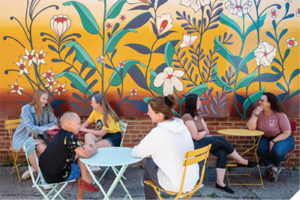Spring Grove Advances 2023 Plan With Help From Rural Design Cohort Program
By Heather Rule

Residents of Spring Grove discussed the need for more space five years ago, especially in regards to the school district’s K-12 building and finding enough space for all the youth sports and arts activities.
Courtney Bergey Swanson grew up in the area and works for the nonprofit Community and Economic Development Associates, contracted by the City of Spring Grove.
“We really were trying to figure out, ‘what would our community look like in 2030, if we could wave a magic wand and do what we felt we needed?’” Bergey Swanson said. “How do we make our educational amenities better for our students so that ultimately they want to choose to come back and raise their own families in Spring Grove?”
She is an adviser on the Spring Grove 2030 committee made up of volunteer representatives from the school district, city, faith communities, local businesses, and nonprofits. The Spring Grove 2030 initiative was aided by a grant and cohort with the Citizen’s Institute on Rural Design (CIRD) in 2022. The plans developed into the idea of creating a new community space in Spring Grove.
Spring Grove 2030 committee gets to work
Through local fundraising, Spring Grove 2030 first raised $30,000 to hire planning and design firm RSP Architects to conduct a comprehensive city planning process, which consisted of nine public workshops, focus groups, and surveys in 2021. Community members were asked what they felt they needed to make Spring Grove “a better place to live, work, raise a family, bring visitors,” Bergey Swanson said. Every student in grades 7-12 was also asked what they wanted to see in the community.
The results pointed to a need for space where people could connect with others whether via school activities, recreation, or a spot to enjoy a cup of coffee with a neighbor.
From there, Spring Grove was one of four communities in the nation selected for the CIRD grant and cohort. CIRD focuses on communities of fewer than 50,000 people and looks to enhance the area’s quality of life through planning and design.
CIRD helps move the plan forward
Spring Grove welcomed the CIRD designers and strategists to town in 2022 for a site visit and later a series of public events and workshops, which provided technical assistance from the designers and strategists. Going off Spring Grove 2030’s previous community engagement work, CIRD designers created potential renderings for a community center. They also talked with people at the local farmers market, seeking their input on what they care about for the area and getting feedback for the potential public space.
Working with CIRD goes beyond receiving grant money, Bergey Swanson said, because it gave Spring Grove the benefit of professional expertise to help guide its vision for the city. In talking with so many people in town, CIRD investigated logistical aspects of the project — for instance, removable chairs or acoustics in a large space to make way for various events like dances, career fairs, or performing arts — and helped turn them into feasible designs. CIRD also helped residents visualize what this new development might look like.
“It was really kind of an intensive process where they learned as much as they could about the community,” Bergey Swanson said. “They talked with as many people as they could.”
Being part of the CIRD cohort was beneficial because it accelerated the process toward the Spring Grove 2030 vision, making the city feel more equipped with information to go forward, Bergey Swanson said. They needed that third-party perspective from the architects and designers to give their expertise with a fresh set of eyes.
“Their creative brains were helpful for us to reimagine how to potentially use what we have for different space needs,” Bergey Swanson said.
The CIRD process resulted in some beautiful design books for Spring Grove 2030 to reference. A site and programming for the new community space are still to be determined. This summer, the school district conducted a feasibility study to determine what could be built to serve both the school and community, along with seeing what the community might support in terms of a referendum, according to Bergey Swanson.
One of the mindsets Bergey Swanson sees in rural communities is a feeling that they don’t deserve nice things or well-designed spaces.
“This is something that I hope other communities would want to take advantage of in the process of really just sitting down and taking the time to ask their citizens what they want to see in the future, and then figuring out how to make that happen,” Bergey Swanson said.
Heather Rule is a freelance writer.

